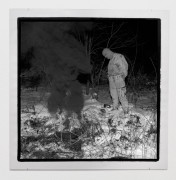As Susan Lipper laconically tells it, a “series of chance events” led her from New York to Grapevine Branch, West Virginia, in the late 1980s. There, in this tiny Appalachian community at the southwestern tip of the state, she “was immediately adopted by most of the inhabitants and, in particular, by a certain family.” She lived among the residents of Grapevine off and on for several years, taking a series of black-and-white photos whose immediacy and intimacy made it clear that she had, indeed, become part of the fold. The images that form “Grapevine,” 1988-92, are mostly of hard-living men–they drink, smoke, fight, and show off scars for her lens–and they plainly bear the influences of Nan Goldin and Jim Goldberg (in particular the latter’s early project Rich and Poor, published as a book in 1985) as much as that of Diane Arbus.
Lipper’s origin story leaves much to be desired, skipping over the question of motivation with the ease of a fairy tale. She offers no indication of why she or the men in her pictures are there, no particulars to grab onto. Also as in fairy tales–the violent ones of the Brothers Grimm, not the sanitized Disney version–“Grapevine” elevates the idiosyncratic and extraordinary to the status of the universal, and revels in blunt, ominous scenes: A man, arms outstretched, wearing a cheap plastic mask, and with a hand clasped over his mouth, stumbles in darkness. A sinewy elder with only one good eye steps through a doorway clutching a revolver in his right hand. A Klansman stands before a pickup truck in a robe and wrinkled hood with misshapen eyeholes. A deer is strung up on a front-yard basketball hoop. At times, the surrounding hillsides are thick with a portentous fog, but often they are simply dark. This is the world of things that go bump in the night.
The images dare us to take them at face value, confirming both our fears of and feelings of superiority toward white, job-starved, rural communities. But they are not documentary, and Lipper explicitly acknowledged a “contract” between her camera and the men before it, giving her subjects license to actively and self-consciously shape their own representations. She shot with a flash and a Hasselblad, whose medium format could not be concealed, and then reviewed the prints with the sitters, allowing them to refine their poses. Throughout, however, Lipper clouds her subjects’ agency with an emphasis on the ramshackle environments these men inhabit. By focusing on details that are not staged but nonetheless signify a makeshift quality–the unpainted pressboard walls of a bedroom, the splintered flass of a pickup truck’s window, a plastic lining tacked unevenly to a hot tub’s outer lip–Lipper calls attention to the ostensibly authentic harsh realities of this dramatized world. The images may be fairy tales, she seems at pains to argue, but they are not fantasy. In an era of “post-truth” and reality TV, such a distinction may seem less critical now than it was twenty-five years ago, but I would argue the opposite. It has become even more important to remind ourselves that the stories we tell, and the ones we record others telling, have more than a symbolic meaning.

